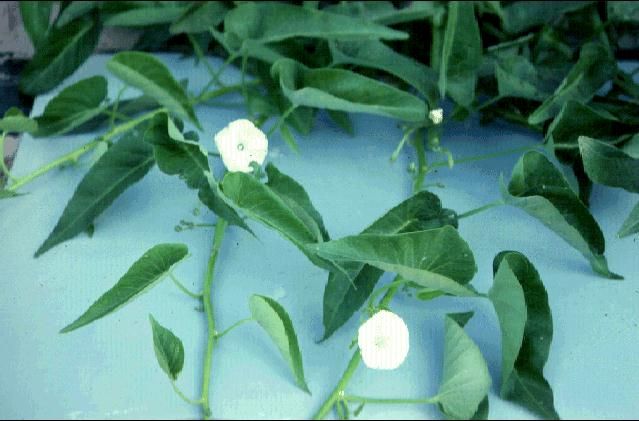Kangkong—Ipomoea aquatica Forsk., also Ipomoea reptans Poir1
Kangkong, also known as water glorybind, water spinach, water convolvulus, and swamp cabbage, is an important green leafy vegetable in Southeast Asia, Taiwan, and Malaysia. It is found throughout the fresh waters of southern China, and is cultivated in countries such as Ceylon. Kangkong has not become very popular elsewhere, particularly here in Florida where its production is discouraged. Our climate is favorable, and given wet soil conditions it would produce well here. Tight precautions should be taken to see that it does not become an established weed in our waterways. The Florida Department of Natural Resources must issue a special permit to anyone wanting to grow kangkong.

Credit: James M. Stephens
Description
There are two forms: upland (dry) and swamp (wet). The plant looks somewhat like the pickerel weed of Florida lakes. The slick surfaced leaves are arrowhead-shaped, 5-6 inches long, narrow, and pointed. It is a trailing hollow vine with alternate leaves and vertical branches arising at the leaf axils. The succulent foliage is light green in color and produces a white flower, followed by a four-seeded pod. There are narrow and broadleaf types, some of which look a lot like sweet potato plants.
Culture
Two types of culture are used: dry and wet. In both cases, large amounts of organic material (compost and manure) and water are used to advantage.
In dry culture, the plants are spaced 5 inches apart in raised beds and are supported by trellises. Kangkong is started from seed or cuttings. Plants are often grown in nursery beds for transplanting later to the garden. Taking cuttings from plants in the nursery beds is the usual method. Harvest may start 6 weeks after planting.
Where wet culture is permitted, 12-inch-long cuttings are planted in mud and kept moist. As the vines grow, the wet areas (paddies) are flooded to a depth of 6 inches and a slow flow of water through the field is maintained similar to methods for watercress. The water flow is stopped for purposes of fertilization. Weeds are controlled by the flooding. Harvest begins 30 days after planting. When the succulent tips of the vines are removed, lateral and upright branches are encouraged. These branches are harvested every 7–10 days.
Plants make the transition to the flowering stage with the short days of winter. During flowering, less vegetative material is available for harvest, but heavy fertilizing and pruning tend to produce more leafy growth.
The frost-sensitive plants are perennial and grow year-round under tropical conditions. Although beds will continue to grow for several years, a build-up of disease, insects, and weeds and soil fertility problems in older established beds make annual culture more desirable. So far, several years of evaluating kangkong in the Everglades show it to be very productive, as it has been at Gainesville using dry culture.
USE
Practically all parts of the young plants are eaten. Since older stems become fibrous, young succulent tips are preferred. These are eaten fresh or cooked like spinach. Cooking in oil is common. Spices should be added to enhance the bland flavor. The canned product is often seen on store shelves.


